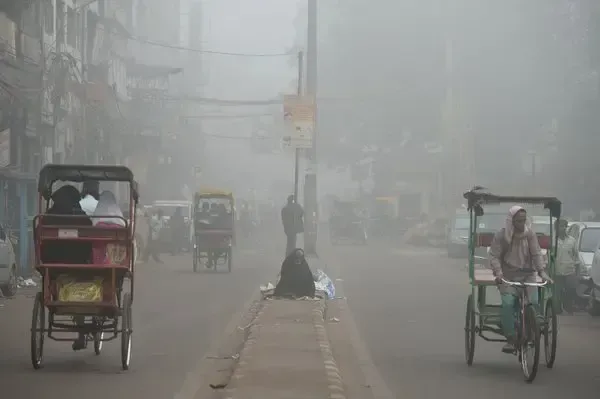Air Pollution in Delhi: A City Choking for Breath

Every winter, Delhi turns into a gas chamber, and November 2025 is proving no different. Despite minor relief reported in a few pockets, the air quality across Delhi-NCR continues to remain in the ‘very poor’ to ‘severe’ category, making the city nearly unbreathable. According to data from the Central Pollution Control Board (CPCB), the overall Air Quality Index (AQI) on November 10, 2025, stood above 380, with several localities such as Bawana, Anand Vihar, and Jahangirpuri recording AQIs beyond 400 — levels considered hazardous for human health.
Current Situation: Toxic Air Engulfs Delhi-NCR
A thick haze has blanketed Delhi for days, reducing visibility and forcing citizens to stay indoors. The Commission for Air Quality Management (CAQM) has decided not to enforce GRAP Stage 3 restrictions yet, citing a slight improvement trend. However, experts warn that the improvement is temporary and largely due to favorable wind conditions rather than reduced emissions.
Delhi’s average AQI readings today:
Bawana: 412
Anand Vihar: 407
Jahangirpuri: 401
RK Puram: 398
IIT Delhi: 377
(Source: CPCB, November 10, 2025)
Public Outcry: ‘We Can’t Breathe’ Protests at India Gate
In a rare show of civic unity, parents, school children, and environmental activists gathered at India Gate demanding immediate government action for clean air. The protest — themed ‘Help Us Breathe’ — saw emotional scenes, with children holding placards reading “Bacche saans nahi lete kya?” (“Don’t children deserve to breathe?”).
However, the peaceful march quickly turned political when Delhi Police detained several protesters, including students from DU and JNU, citing “unauthorized assembly.”
Opposition leaders like Rahul Gandhi criticized the detentions, calling it “criminalizing the right to breathe.”
Government Response: Measures Announced So Far
Delhi Chief Minister Rekha Gupta announced that staggered office timings and work-from-home options would begin from November 15 to reduce vehicular traffic.
Other steps in motion:
Sprinkling of treated water on roads (though critics allege water was used on AQI sensors to manipulate readings).
Ban on diesel generator sets except for emergency services.
Closure of construction and demolition activities in high-emission zones.
Free distribution of N95 masks in government schools.
Despite these measures, environmental watchdogs say implementation remains weak, and Delhi’s ₹20-crore smog tower has once again failed to show measurable results.
Health Impact: The Invisible Killer
Doctors have declared the situation a “public health emergency.”
According to AIIMS specialists:
1 in 3 children in Delhi now shows signs of reduced lung capacity.
There’s been a 42% increase in respiratory illness cases this month.
Long-term exposure is linked to chronic bronchitis, asthma, heart disease, and even early cognitive decline in children.
Citizens report irritation in eyes, sore throat, fatigue, and difficulty in breathing even indoors. The elderly and those with pre-existing conditions are at the highest risk.
The Political Blame Game
As Delhi gasps, political blame-shifting has intensified.
The AAP government accuses the BJP-led Centre of neglecting pollution control and “reducing pollution figures, not pollution itself.”
The Centre, in turn, blames stubble burning in Punjab and Haryana, calling it a “state responsibility.”
Satellite images from NASA’s MODIS confirm that over 4,500 farm fires were detected across Punjab in the last week alone.
Meanwhile, the CAQM continues to face criticism for being “reactive, not preventive.”
Expert Insights: What Needs to Change
Environmental experts and think tanks have proposed several actionable steps:
Implement GRAP Stage 3 curbs immediately instead of delaying them for political reasons.
Shift public transport fleet to full electric by 2027.
Introduce real-time emission tracking for industrial zones.
Incentivize crop residue management to reduce stubble burning.
Create green buffers and expand Delhi’s tree cover beyond 23%.
As Down To Earth notes, faulty air monitors and inconsistent readings are also masking the true extent of the crisis.
Future Outlook: Hope or Hazard?
Meteorological forecasts suggest that a light northwesterly wind could bring minor relief in the coming days, but experts warn that without structural changes, Delhi will continue to face “toxic winters.”
Climate activists argue that the capital’s pollution battle is not a seasonal problem but a year-round failure in policy enforcement and civic planning.
Conclusion: A City That Deserves To Breathe
Delhi’s pollution problem is not new, but public outrage this year shows a growing awareness and urgency. As citizens take to the streets, it’s a reminder that clean air is not a privilege — it’s a fundamental right.
Unless authorities act decisively and citizens change habits, Delhi risks becoming a cautionary tale for urban collapse under its own smog.
Press Release on Our All Websites for Powerful Online Presence
Get your brand featured with a world-class press release, published across all our high-authority websites — complete with powerful do-follow backlinks. Crafted to meet global press release standards, our service ensures maximum credibility, visibility, and SEO impact. Special pricing and exclusive offers are available for a limited time. Contact us today at sunil@justbaazaar.com to elevate your brand’s presence."
Created with © systeme.io









